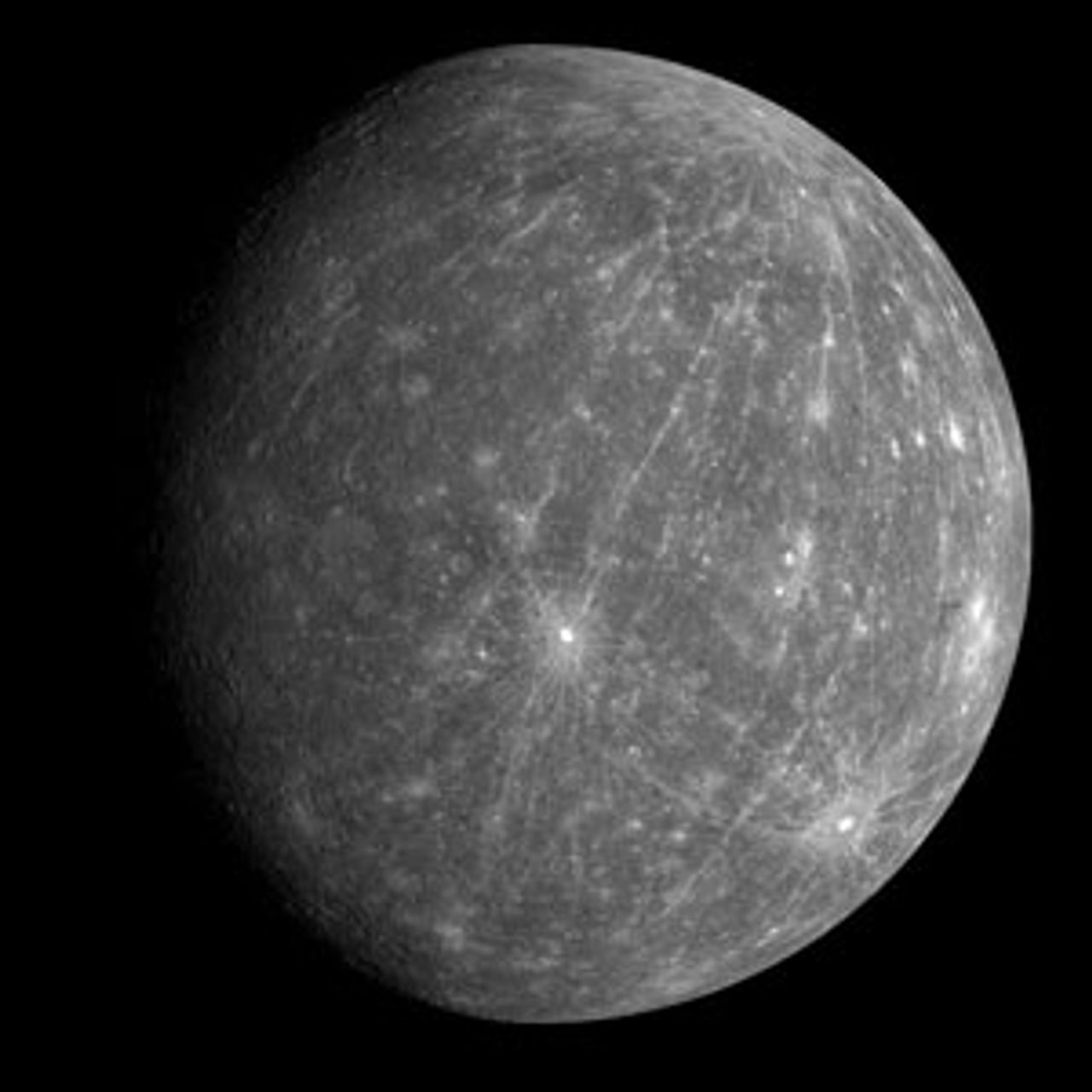The spacecraft Messenger successful entered an orbital path around the planet Mercury March 17, making it the first to take up a long-term station around the innermost planet of the solar system. The spacecraft fired its main thruster for 14 minutes, slowing its rush towards the Sun sufficiently for it to be captured by the weak gravity of Mercury, the smallest planet.
 This view is one of the first from the MESSENGER
This view is one of the first from the MESSENGER probe’s October 6, 2008 flyby of Mercury.
CREDIT: NASA/JHUAPL/CIW
Messenger will maintain an elongated elliptical orbit for about a year, although because the planet rotates so slowly, once every 176 Earth days, the mission will last for only two Mercury days. The spacecraft will circle the planet once every 12 hours, with its closest approaches within 120 miles (200 kilometers) from the planet, and its furthest some 9,300 miles (15,000 kilometers) away.
Because of the enormous pull of the Sun’s gravity, NASA engineers will have to fire Messenger’s main engine every few months to push it back towards Mercury. The first such orbital correction maneuver is planned for mid-June.
Messenger’s name is both a convoluted acronym (MErcury Surface, Space ENvironment, GEochemistry and Ranging) and a tribute to Mercury, messenger of the gods in Greek mythology, for whom the fastest-orbiting planet is named.
The spacecraft was launched in August 2004, and it has made a circuitous trip of 4.9 billion miles (7.9 billion kilometers) through the inner solar system. In order to economize on fuel and reach the correct position and speed for entering orbit around Mercury, Messenger has performed flyby maneuvers around the Earth, then twice around Venus, and finally three times around Mercury.
Messenger will orbit Mercury for an entire Earth year before it finally crashes into the surface of the planet. It will deploy a package of seven instruments to conduct unprecedented mapping and imaging in visible, ultraviolet and infrared wavelengths, using both wide-angle and narrow-angle cameras. Other instruments will provide spectrometer analysis of Mercury’s surface composition, its gravitational and magnetic fields, and of the solar particles and plasma that regularly blast the closest planet to the Sun.
Scientists at the Johns Hopkins University Applied Physics Laboratory began turning on the spacecraft’s instruments March 23, and reported that six were operating properly. The seventh, the digital imaging system, will begin operating on March 29, and the first photographs taken by Messenger from Mercury orbit are due to arrive that day.
The spacecraft’s orbit is inclined 82.5 degrees to Mercury’s equator, putting the spacecraft in good position to observe the planet’s north pole, where mission scientists hope to find evidence of ice.
Despite its close proximity to the Sun, which brings the surface temperature on the sunny side to 800 degrees Fahrenheit, Mercury’s slow rotation keeps the other side largely dark, with temperatures about 300 degrees below zero. At some point along the border between light and dark, the temperature would permit frozen water to exist.
The insertion into Mercury orbit was an exceptional feat of engineering skill, given that the spacecraft was only 28 million miles (46 million kilometers) from the Sun, and 96 million miles (155 million kilometers) from the Earth. The great distance from the Earth made communication difficult, since radio signals require eight minutes to reach the spacecraft. The closeness to the Sun subjects Messenger to intense heat and radiation, as well as potentially interfering with its communications.
“Achieving Mercury orbit was by far the biggest milestone since Messenger was launched more than 6 and a half years ago,” said Peter Bedini of the Applied Physics Laboratory in a statement. “This accomplishment is the fruit of a tremendous amount of labor on the part of the navigation, guidance-and-control, and mission operations teams, who shepherded the spacecraft through its 4.9-billion-mile (7.9 billion km) journey.”
The total cost of the Messenger mission is $446 million, less than the Pentagon spends every six hours. It is the first space mission to Mercury since Mariner in the mid-1970s, which conducted flybys of Venus and Mercury, but with instruments much inferior to those on Messenger. One scientist, Robert Strom of the University of Arizona, participated in both missions, 36 years apart.
NASA engineers spent two decades developing materials and technologies specifically for this mission. These included a graphite epoxy material for the structure that could withstand launch and still be light enough to cut fuel costs on the long voyage, and a ceramic-fabric sunshade to protect the spacecraft from the heat of the nearby Sun as it approached Mercury.
Among the myriad topics to be investigated on several key questions outlined by NASA officials: the nature of Mercury’s core, believed to be largely iron, and more metallic than that of the Earth, since Mercury is far denser; the nature of the planet’s magnetic field; and its very tenuous atmosphere, far thinner even than that of Mars.
They also expect to study the massive impact crater made by an asteroid that struck Mercury about 4 billion years ago. The asteroid, about 60 miles in diameter, created a crater nearly 1,000 miles across, know as the Caloris Basin, so large it could hold the entire state of Texas.
Mercury travels through space at nearly 112,000 miles per hour (180,000 kilometers per hour), making it the fastest planet. Its orbit is highly elliptical, with a closest approach of 29 million miles (47 million kilometers), when the Sun would appear more than three times as large as it does from the Earth.
